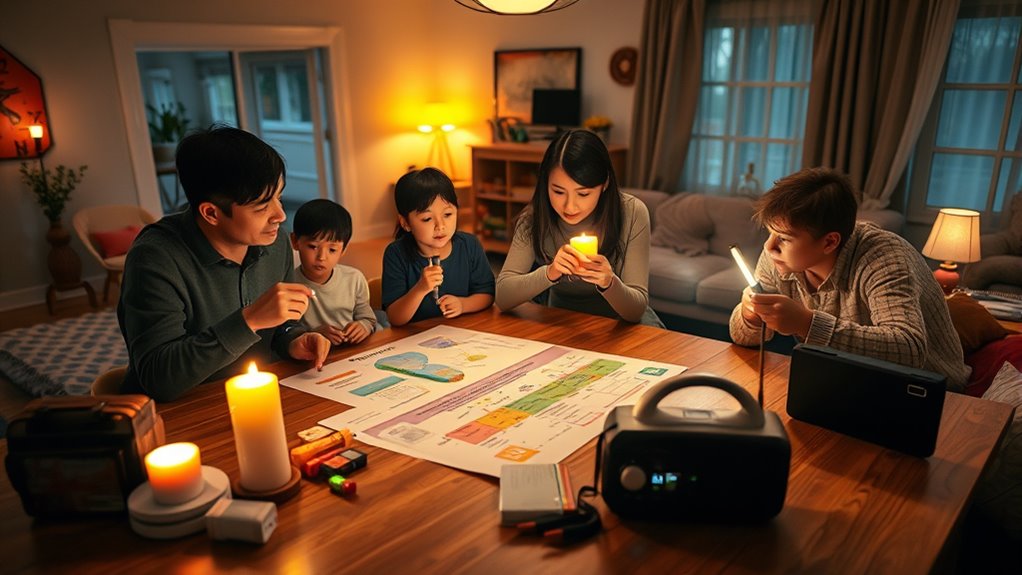To make a family communications and safety plan for blackouts, start by evaluating your family’s needs and risks, then designate a reliable contact outside your area. Establish clear communication methods, like radio or charged phones, and identify safe meeting spots nearby. Prepare an emergency kit with supplies and store important information in accessible, waterproof containers. Incorporate backup power sources and rehearse your plan regularly—this way, everyone stays safe and connected during outages. Learn more to keep your family prepared.
Key Takeaways
- Designate a reliable family emergency contact outside the affected area and share updated contact information.
- Establish multiple communication methods such as cell phones, radios, and walkie-talkies, and ensure devices are charged.
- Develop and practice clear communication protocols, including signals, message priorities, and backup channels.
- Create a list of safe meeting places outside the home and rehearse evacuation and reunion plans regularly.
- Prepare an emergency kit with essential supplies, including communication tools, and keep it accessible and updated.
Assess Your Family’s Emergency Needs and Risks
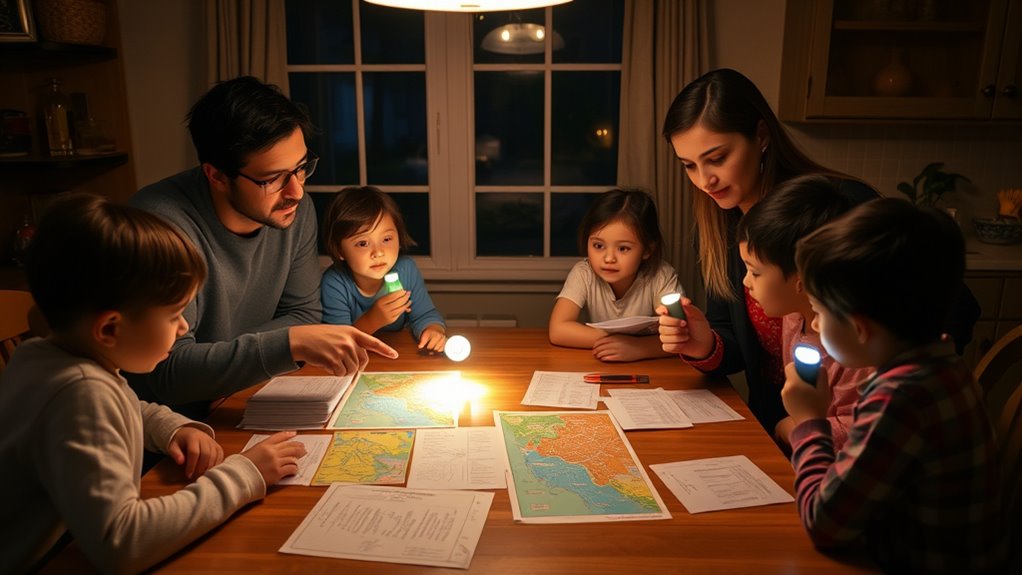
Before a blackout occurs, it’s vital to evaluate your family’s emergency needs and risks. Identify essential supplies, such as food, water, medications, and battery-powered devices, to guarantee your family can stay safe and comfortable. Consider family members’ specific needs, like infants, seniors, or those with health conditions, and plan accordingly. Assess your home’s infrastructure—check for vulnerable wiring, backup power options, or potential hazards. Think about your neighborhood’s risks, including weather patterns or history of outages, to better prepare. Recognizing these factors helps you develop a tailored plan, reducing panic and confusion during an actual blackout. Being proactive now ensures you’re ready to handle unexpected disruptions calmly and effectively.
Designate a Family Emergency Contact Person

Choosing a designated family emergency contact person is a crucial step in your blackout preparedness plan. This person acts as a central point for family members to check in and share updates. To select the best individual, consider these factors:
Designate a reliable contact outside your area to coordinate family updates during a blackout.
- They should be reliable and easy to reach.
- Reside outside the immediate affected area.
- Have access to a phone or alternative communication methods.
- Be familiar with your family’s situation and needs.
- Ensure they understand the importance of communication reliability during emergencies.
- It’s also helpful if they are comfortable managing emergency communication and providing reassurance to other family members. Additionally, choosing someone with experience in crisis management can enhance your family’s overall safety and coordination during blackouts. Recognizing the role of attention in effective communication can also improve their responsiveness in critical moments.
Establish Clear Communication Methods and Channels
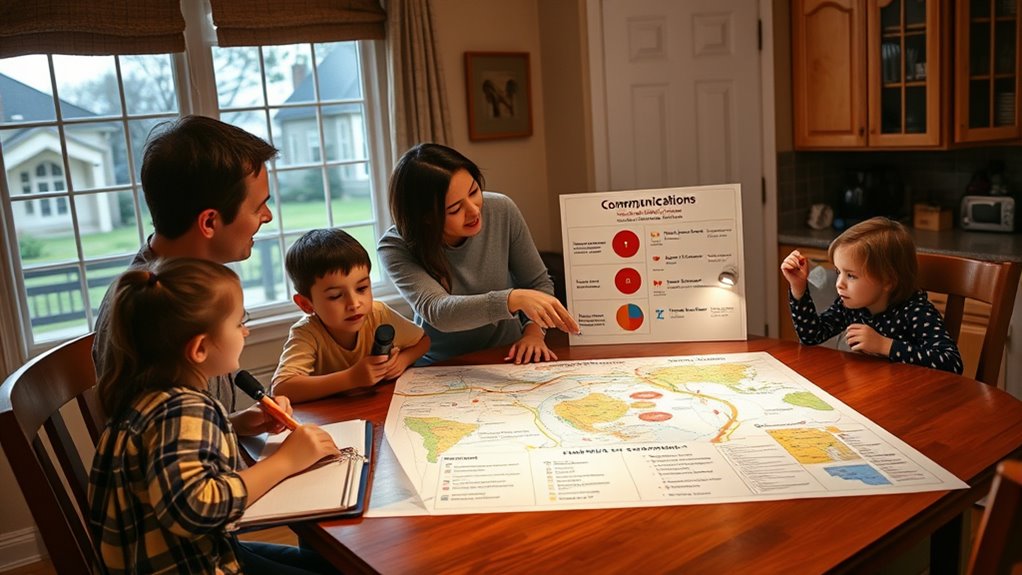
Establishing clear communication methods and channels is essential to keep your family connected during a blackout. Decide how everyone will stay in touch if phones or internet are unavailable. Use multiple methods to ensure redundancy. For example, assign specific communication tools:
| Method | Purpose | Backup Option |
|---|---|---|
| Cell Phones | Quick updates and contact | Walkie-talkies |
| Emergency Radio | Receive alerts and broadcast messages | Battery-powered radio |
| Family Meet Codes | Recognize messages without sound | Hand signals or written notes |
Make sure everyone knows how to use each method. Keep devices charged and accessible. Practice your communication plan regularly so your family can respond quickly and stay safe, no matter what happens during a blackout. Practicing communication strategies helps ensure everyone remains prepared and confident in using the chosen methods. Incorporating electric bikes as an alternative transportation option can be beneficial in emergencies, especially when conventional vehicles are unavailable or impractical. Additionally, understanding emergency preparedness techniques can further enhance your family’s safety during such events, including planning for power outages and other disruptions.
Identify Safe Meeting Places
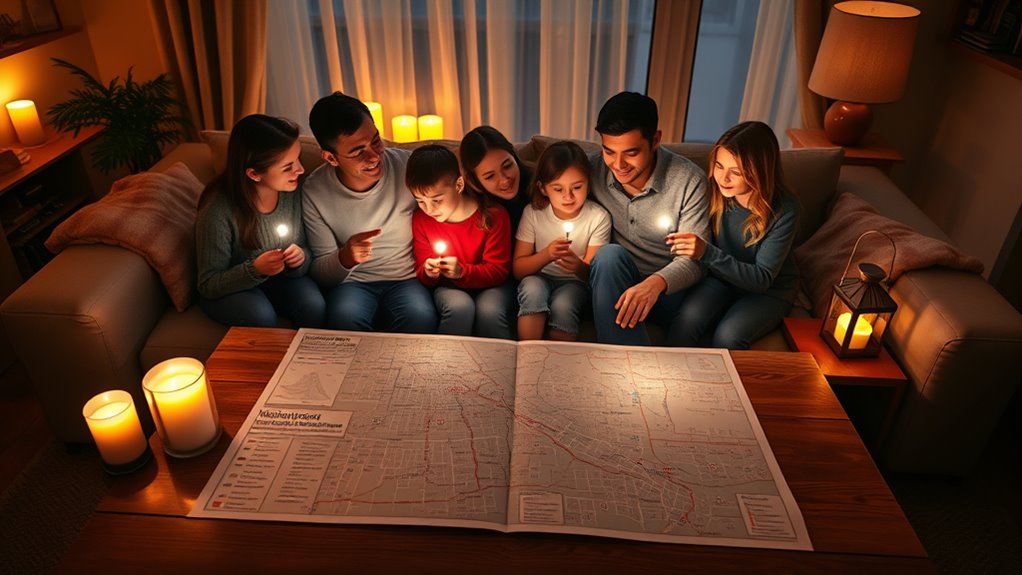
Once you’ve set up clear communication methods, it’s important to know where your family will meet if you can’t connect through phones or radios. Choose safe, accessible locations that everyone can reach easily. Consider these options:
- A neighbor’s house within walking distance
- A public park or open space nearby
- The local community center or library
- Your designated emergency shelter or family’s primary residence
Make sure each family member knows the exact addresses or landmarks of these places. Discuss how to reach each location quickly and safely. Establishing these meeting spots ensures you can reunite if communication lines go down, reducing confusion and stress during an emergency. Regularly review and update these locations as needed. Additionally, practicing your family’s emergency plan can help everyone feel more confident and prepared in real situations.
Prepare a Family Emergency Kit
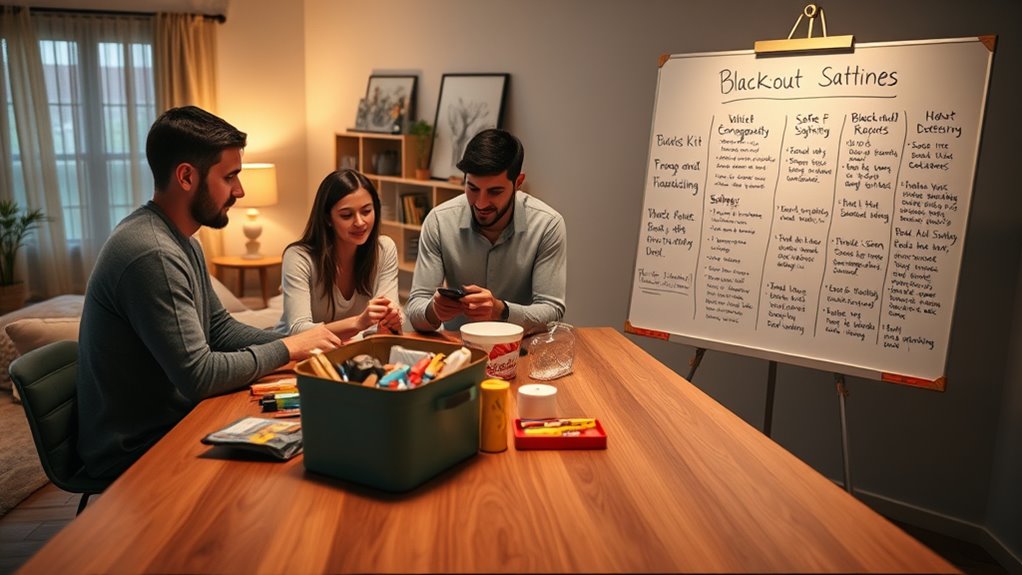
You should gather an emergency kit with essential supplies like water, non-perishable food, and first aid items. Use proper storage techniques to keep everything safe and accessible, even if conditions change. Remember to review and update your kit regularly to guarantee all items are current and ready when needed. Additionally, consider including items that can assist with communication and safety, such as a portable radio or flashlights, especially if power outages occur. Proper storage techniques are vital for maintaining the safety and usability of your supplies during emergencies, ensuring quick access when every second counts. Incorporating emergency preparedness strategies into your planning can further enhance your family’s safety during blackouts. Pinball machines, with their advanced technology and design, highlight the importance of being prepared with the right tools and supplies during emergencies. Ensuring your kit contains necessary and functional items can make a significant difference in critical moments. Being aware of family communication plans can also help coordinate efforts and keep everyone safe during blackouts.
Essential Supplies Checklist
A well-stocked emergency kit is crucial for keeping your family safe during blackouts. It ensures you have vital supplies ready when power is lost. To start, gather the following items:
- Non-perishable food and water to last at least three days
- Flashlights with extra batteries for reliable lighting
- First aid supplies to address minor injuries
- Essential medications, including prescriptions and backups
Having these core items on hand helps you respond quickly and reduces stress during an outage. Keep the supplies organized in a waterproof container and check them regularly to replace expired items. Remember, a prepared kit is your first line of defense, providing peace of mind and safety for your family when blackouts occur.
Proper Storage Techniques
Proper storage techniques are essential to keep your emergency kit organized, accessible, and in good condition. Choose a sturdy, waterproof container to protect your supplies from moisture and damage. Keep your kit in a designated, easily reachable location, such as a closet or basement, so everyone can access it quickly during an emergency. Label the container clearly with “Emergency Kit” to avoid confusion. Store items in airtight containers or resealable bags to prevent spoilage and contamination. Rotate perishable items regularly to ensure freshness, and avoid overpacking so the kit remains manageable. Keep a written inventory nearby to quickly verify contents. Proper storage not only preserves your supplies but also ensures you can grab everything you need swiftly when seconds matter. Additionally, staying informed about emerging data privacy challenges can help you understand how to safeguard your information during emergencies. Ensuring your safety also involves being aware of toilet maintenance and how to address issues like clogs or running toilets, which can become problematic during power outages or water shortages. Regularly inspecting your emergency supplies and sauna heater systems can help prevent unexpected failures during crises. Maintaining a self watering plant pot can be beneficial for growing medicinal herbs or food sources in a crisis, ensuring they stay healthy with minimal effort. Incorporating merchant services considerations, such as secure payment options, can also be useful if you need to make emergency transactions quickly.
Regular Kit Updates
Regularly updating your family emergency kit guarantees that all supplies are current, functional, and ready when needed. Check expiration dates on food, water, medications, and batteries at least every six months. Replace expired items immediately to ensure safety and effectiveness. Review your kit’s contents to identify missing or outdated supplies, and replenish them promptly. Ensure your contact information and important documents are current and accessible. Additionally, update your kit based on seasonal needs or changes in your family’s circumstances.
- Verify expiration dates and replace expired items
- Restock consumables like food, water, and medications
- Update important documents and contact info
- Adjust supplies for seasonal or family-specific needs
Develop a Family Emergency Plan and Schedule Practice Drills
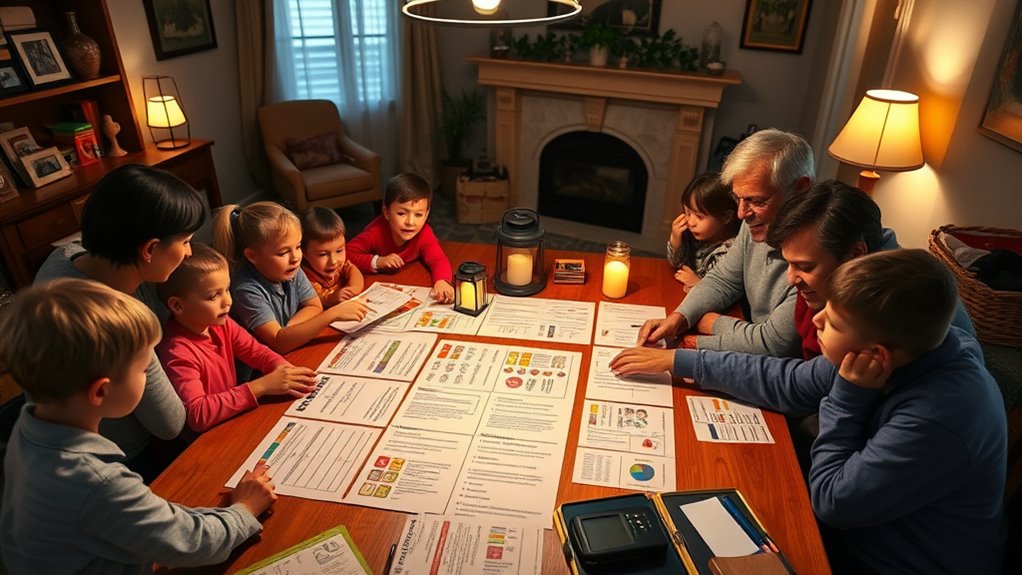
You need to create a clear family emergency plan that everyone understands. Assign specific roles and establish reliable communication methods to stay connected during blackouts. Practice your drills regularly to make certain your family responds quickly and confidently in a real emergency. Incorporating structured routines can help maintain consistency and reduce stress during unexpected events.
Establish Communication Methods
Creating a clear family emergency plan is essential for effective communication during blackouts. You need reliable methods to stay connected when usual channels fail. First, select primary and backup communication devices, such as cell phones, walkie-talkies, or battery-powered radios. Second, establish a designated meeting spot outside your home and another nearby safe location. Third, share a list of emergency contacts, including neighbors, friends, and local authorities. Fourth, ensure everyone knows how to use the chosen devices and understands the plan. Regularly test these communication methods during practice drills to confirm everyone’s familiarity. Keeping these methods clear and accessible guarantees your family stays connected, informed, and safe even when power and services go out unexpectedly.
Assign Emergency Roles
Have you assigned specific emergency roles to each family member? Clearly defining roles ensures everyone knows their responsibilities during a blackout. For example, designate someone to handle first aid or check on vulnerable neighbors. Assign a person to gather emergency supplies or locate important documents. Choose a family member to manage communication with emergency services or neighbors if needed. Make sure each person understands their role and feels confident in performing it. This family emergency plan can help coordinate efforts and reduce confusion during a crisis. Keep roles simple, and consider each person’s strengths and abilities. Writing down these roles and reviewing them regularly helps reinforce your plan. When everyone knows their part, your family can respond quickly and effectively when a blackout occurs. Additionally, incorporating home safety measures such as securing flashlights and emergency kits ensures readiness.
Conduct Regular Drills
Once emergency roles are assigned, the next step is to guarantee everyone knows how to respond effectively by conducting regular drills. Practice helps identify gaps and ensures preparedness. Here’s how to do it:
- Schedule drills at least twice a year, involving all family members.
- Simulate different blackout scenarios to test your response plans.
- Assign specific tasks to each person, such as locating flashlights or shutting off utilities.
- Review and discuss the responses afterward, addressing any confusion or delays.
- Incorporate safety measures like checking smoke detectors or securing loose wires into your drills to enhance overall readiness. Implementing emergency preparedness concepts can significantly improve your family’s safety during unexpected situations. Regularly updating your survival gear and practicing their use can further boost your response effectiveness. Understanding the beach body principles, such as proper hydration and skin protection, can also help keep everyone healthy during extended emergencies.
- Including training in basic first aid and CPR can prepare your family to handle injuries during an emergency, increasing overall safety and confidence.
Regular practice builds confidence and reinforces safety habits. Keep drills realistic but manageable, and adjust them as your plan evolves. Consistency is key to ensuring everyone reacts quickly and correctly during an actual blackout.
Share Important Emergency Information and Resources
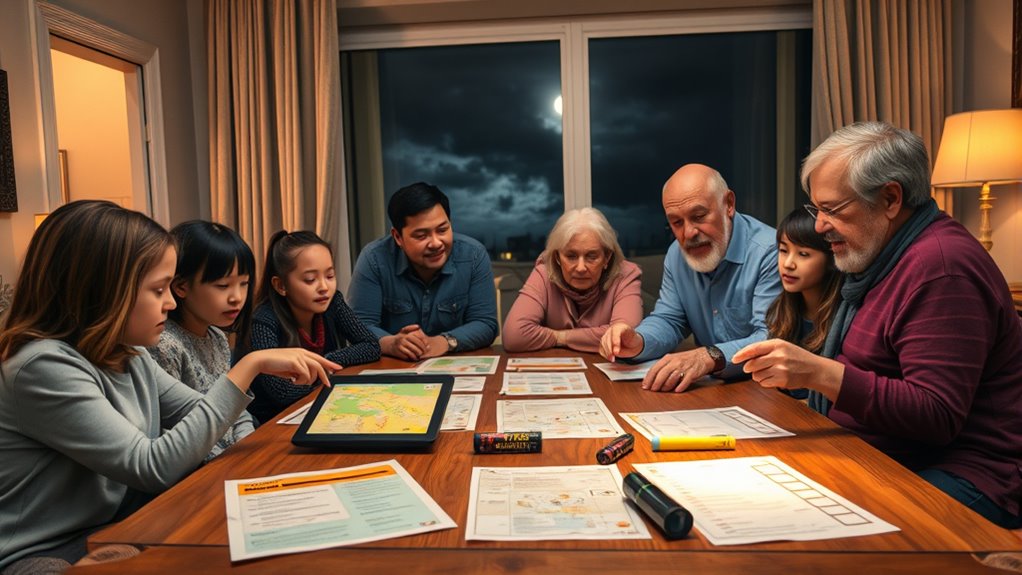
Why is sharing your emergency information and resources essential during a blackout? Because it guarantees everyone in your family knows how to access critical contact details, medical info, and local emergency services quickly. When phone lines or internet are down, having hard copies of important numbers, addresses, and medical instructions can save precious time. Distribute printed lists or keep a small, waterproof emergency kit with this information. Sharing resources also includes educating your family about nearby shelters, hospitals, and community centers. Clear communication reduces panic and confusion, helping everyone stay safe and coordinated. Make sure each family member understands where to find this information and how to use it. Being prepared with accessible, shared emergency info strengthens your family’s resilience during blackouts.
Incorporate Technology and Backup Power Solutions
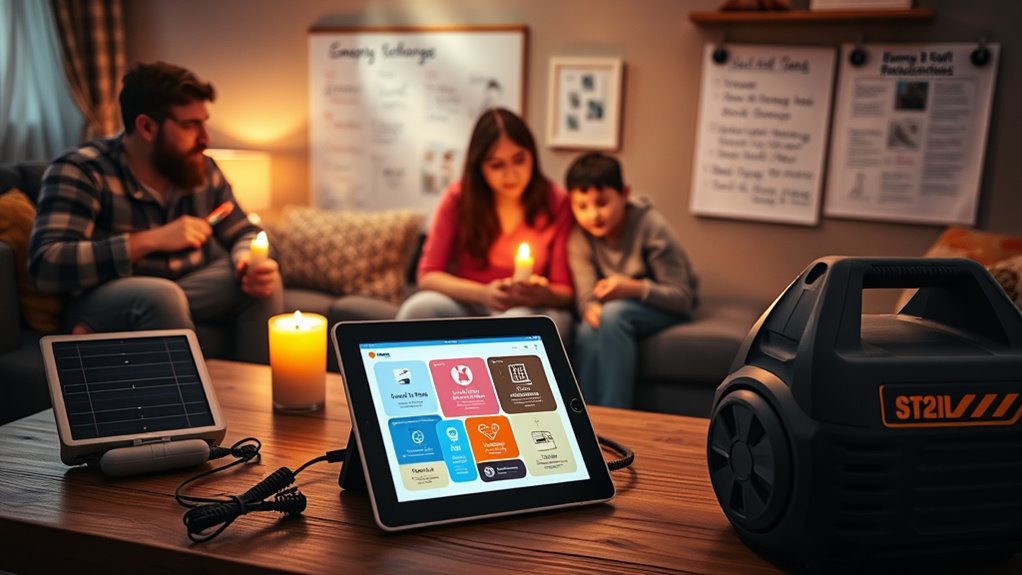
To stay connected during blackouts, you should have emergency charging devices ready to power your phones and essential gadgets. Satellite communication options can help you reach others when cell networks are down, ensuring you’re not isolated. Additionally, backup power sources like generators or solar panels can keep critical appliances running when the power grid fails.
Emergency Charging Devices
Having reliable emergency charging devices is essential to stay connected during blackouts. These devices ensure your family can access critical information, communicate, and stay safe. Consider these options:
- Portable power banks: Compact and versatile, they can charge smartphones and small devices multiple times.
- Solar chargers: Eco-friendly and renewable, they harness sunlight to recharge devices, ideal for prolonged outages.
- Hand-crank chargers: Manual power sources that generate energy through physical effort, useful when no sunlight is available.
- Uninterruptible Power Supplies (UPS): Designed for essential electronics, they provide backup power during outages and protect against surges.
Choose devices based on your family’s communication needs and power consumption. Regularly test and keep them charged to ensure readiness when needed.
Satellite Communication Options
During a blackout, traditional cell service and internet connections can become unreliable or unavailable, making satellite communication options a vital part of your family’s safety plan. Satellite phones operate independently of cell towers, connecting directly to orbiting satellites to provide voice and data services. Investing in a satellite phone guarantees you can contact emergency services or loved ones when terrestrial networks fail. Keep in mind that satellite devices require a clear line of sight to satellites, so avoid obstructions like buildings or dense foliage. Additionally, consider portable satellite terminals or mesh networks that can extend coverage in remote areas. Regularly test your equipment to verify functionality during emergencies. Having satellite communication options ready ensures you stay connected, informed, and able to coordinate with others when conventional networks are down.
Backup Power Sources
When the power goes out, reliable backup power sources become essential for maintaining communication, lighting, and other critical functions. Having a few options ensures your family stays connected and safe. Consider these solutions:
- Generator – A portable or standby generator can run essential appliances and devices, but requires fuel and proper ventilation.
- Solar Power Banks – Rechargeable solar-powered batteries can keep phones and small devices charged without electricity.
- Uninterruptible Power Supplies (UPS) – Ideal for computers and communication devices, providing short-term backup during outages.
- Battery-Powered Lights – Keep flashlights, lanterns, and headlamps handy for lighting when the power’s out.
Educate Family Members About Emergency Procedures

Educating your family members about emergency procedures guarantees everyone knows how to respond quickly and safely during a blackout. You should explain how to turn off appliances and utilities to prevent hazards. Make sure everyone understands how to use flashlights and avoid candles to reduce fire risk. Teach family members how to communicate if cell service is disrupted—such as using predetermined signals or meeting points. Practice these procedures regularly so they become second nature. Clarify how to handle medical needs, including medication storage and assistance. Encourage questions to ensure understanding and confidence. By thoroughly educating your family, you reduce panic and confusion when a blackout occurs, enabling everyone to act swiftly and safely. Clear knowledge is your best defense during an emergency.
Review and Update Your Plan Regularly
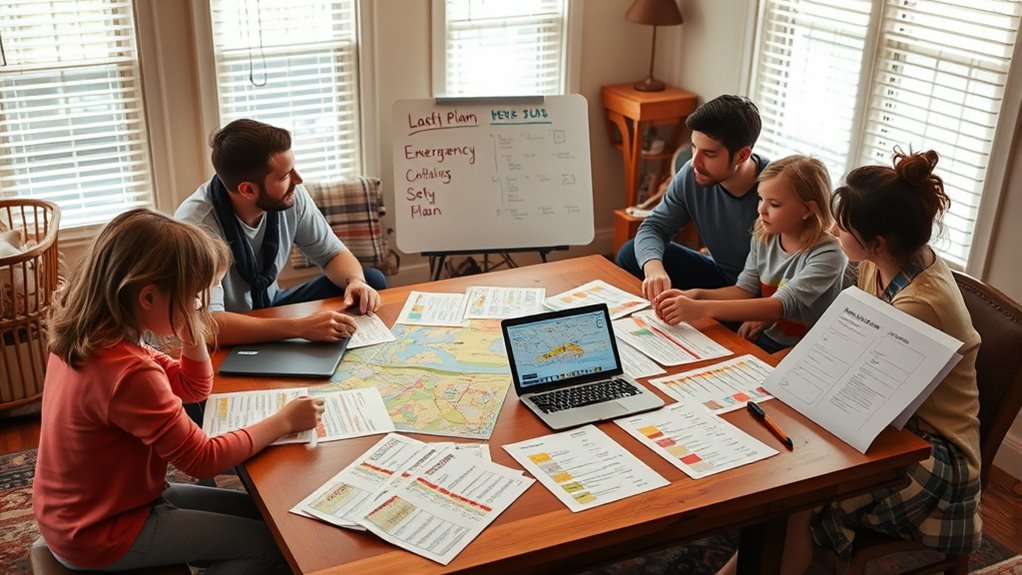
Regularly reviewing and updating your blackout safety plan guarantees it remains effective and relevant as circumstances change. To do this, set a schedule, such as every six months, and stick to it. During each review, consider these key points:
- Verify contact information for all family members and emergency services.
- Test communication methods like radios or cell phones.
- Update supplies, including batteries, flashlights, and first aid kits.
- Reassess family members’ roles and responsibilities during an emergency.
Frequently Asked Questions
How Often Should We Review and Update Our Family Emergency Plan?
You should review and update your family emergency plan at least once a year, ideally during daylight saving time changes or family gatherings when everyone’s together. Additionally, update it after any major life changes, like moving, new family members, or significant health updates. Regular reviews guarantee everyone stays familiar with the plan, and you’re prepared for unexpected blackouts or emergencies, keeping your family safe and informed.
What Are the Best Communication Apps for Emergency Situations?
You should consider using reliable communication apps like WhatsApp, Signal, or Zello during emergencies. These apps work over Wi-Fi or mobile data, enabling you to stay in touch even when traditional networks are down. Make certain everyone in your family downloads and tests these apps regularly. Keep backup power sources, like portable chargers, handy. This way, you guarantee your family stays connected and informed during blackouts or other crises.
How Can I Involve Children in the Emergency Planning Process?
You can involve children in emergency planning by explaining the importance of safety in simple terms, then asking for their ideas. Make it interactive by practicing drills together and teaching them how to use communication devices. Use age-appropriate language and include them in creating a family plan, so they feel empowered and prepared. This helps build confidence and guarantees they understand their role during emergencies.
What Are Some Low-Cost Backup Power Options for Blackout Safety?
You can use portable power banks to charge essential devices like phones and flashlights, and invest in a small, affordable solar charger for continuous power. Battery-powered LED lanterns or flashlights are cost-effective and reliable during blackouts. Consider a hand-crank radio for updates, and keep spare batteries handy. These options are budget-friendly, easy to use, and guarantee you stay connected and safe without breaking the bank.
How Do We Coordinate With Neighbors During a Blackout Emergency?
You should introduce yourself to neighbors and exchange contact information beforehand. Establish a communication plan, like checking on each other regularly through phone calls or messages. Agree on a safe meeting point and share resources such as flashlights or battery packs. During a blackout, stay calm, keep your phone charged, and coordinate via your established channels. Working together helps guarantee everyone stays safe and informed until power is restored.
Conclusion
By creating and regularly updating your family communications and safety plan, you’ll be prepared for blackouts and other emergencies. Make sure everyone knows the procedures, has access to essential resources, and stays connected. Practice your plan so it feels familiar and confident. Remember, staying proactive and informed helps keep your family safe and secure in any crisis. With these steps, you’ll be ready to face power outages confidently and calmly.

